Enjoy DatePsychology? Consider subscribing at Patreon to support the project.
“Body count” is a colloquialism referring to one’s number of past sexual partners. In this article I will explore recent survey data on “body count” experiences and preferences. No long introduction — let’s dive right into the data.
Descriptive Statistics of the Sample

This data consists of 660 participants (148 women). The mean age for men was 33 and for women was 30. Most men were heterosexual, while 31% of women reported that they were bisexual.

A fairly close percentage of men and women reported being in a committed relationship, married, and divorced.

The average number of sexual partners for men and women was 20 and 19 respectively. This is substantially higher than indicated in representative datasets. The median number of partners for men and women was 7. Men and women were also close in reporting no sexual activity over the past 12 months and the past three years.
Sex Differences in “Body Count” Importance

I asked participants to rate the importance of past partner count, or “body count,” on a 1-7 Likert scale. I did not find a sex difference for perceptions of one’s own past partner count in a committed relationship. In other words, men and women believed that their own partner count would be equally important to a romantic partner.
There was a sex difference in perceptions of a romantic partner’s “body count.” Men perceived the past sexual history of a potential romantic partner as more important than women did.
Men, but not women, also believed that their “body count” mattered to the opposite sex more than it really did.
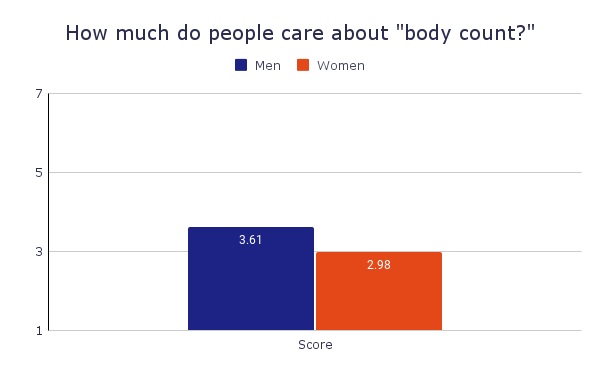
Given that the midpoint of the Likert scale was a 4, average scores of 3.23 and 3.45 indicate that neither men nor women assigned a high importance to the “body count” of themselves or others.
Desire For Monogamy and Openness to Casual Sex

I asked men and women to indicate their desire for a monogamous relationship and their openness to casual sex on a 1-7 scale. Men were significantly more likely to be open to casual sex and significantly less likely to desire a monogamous relationship. The difference in openness to casual sex is larger, consistent with past research on sex differences in sociosexuality. The difference in a desire for monogamy is small.
Estimation of Past Sexual History of Others

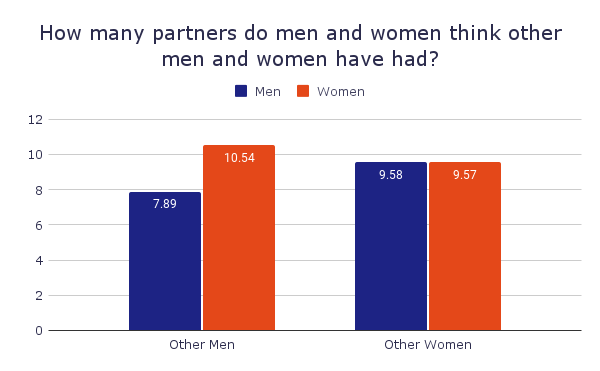
Participants estimated the past number of sexual partners of men and women. Women believed that men had significantly more sexual partners. However, men and women both provided a similar estimate of sexual partners for women.
Actual and Ideal Past Partner Preferences

Participants reported the number of past sexual partners of their current romantic partner, as well as their stated ideal in a romantic partner. Approximately 30% of men and 25% of women stated that they did not know what their current romantic partner’s past sexual count was.
Women reported a higher average, but an equal median, of past sexual partners in their romantic partner. A slightly higher percentage of women reported that they had no ideal past number in a romantic partner. Women also reported a significantly higher ideal number of past sexual partners. The median for men was 2 and the median for women was 5. Women wanted their partners to be more sexually active than men desired of their partners.
Has Been Asked For Partner Count

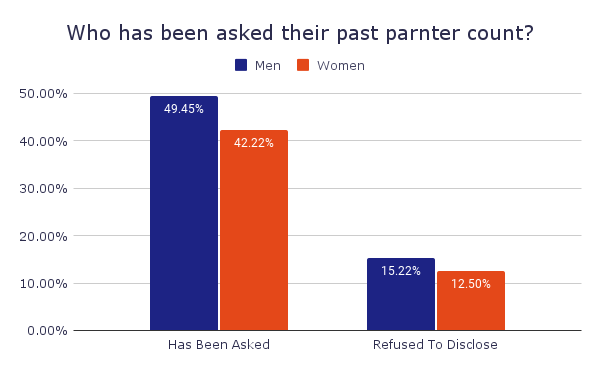
Slightly less than half of men and women have been asked by their current romantic partner what their own “body count” is. Men were more likely to report having been asked, but this difference was not statistically significant. A similar, but smaller, percentage of men and women have also refused to disclose their past partner count when asked.
When Is Body Count Queried

Participants reported if they ask their dates about their sexual partner history and on what date. Relatively few ask early in the dating process, or before the first date. Below is a chart for men and women with participants who don’t ask removed, representing about half of the sample.
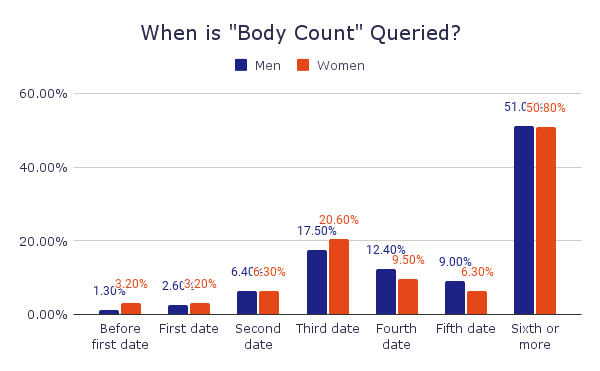
Past Partners and Ideal Body Count Preferences

The table above shows the percentage of participants who reported that they had no ideal, grouped by their own past sexual history. Men and women with a lower number of past sexual partners were more likely to indicate that they had an ideal “body count” in a committed romantic partner.
Openness to Casual Sex, Self and Partner “Body Count”
Openness to casual sex predicted having a higher number of past sexual partners for men (r = .26, p < .001), but not for women. Openness to casual sex also predicted having a current committed romantic partner with a higher number of past sexual partners for men (r = .18, p = .004) and for women (r = .35, p = .001). In short, more promiscuous individuals are more likely to select more promiscuous partners even for long term relationships.
Testing “The Wall”
A popular Internet meme is that women may have difficulty finding a romantic partner around age 30 if they have a promiscuous history. Including only women 30 and above, I tested if unmarried women would have a higher partner count. The mean number of past sexual partners for married women was 10.09 with a median of 7 and for unmarried women was 13.42 with a median of 8. This was not significantly different (t(60.27) = -0.912, p = 0.366).
Unmarried men, however, did have a significantly higher number of sexual partners within this age group. The mean for unmarried men was 20.07 with a median of 12 and for married men was 14.49 with a median of 8 t(232.92) = -2.4409, p = 0.0154).
Discussion
Sexual Double Standards (SDS) is a term used in psychology to describe how men and women may evaluate the same sexual behavior of the opposite sex differently (Gómez-Berrocal, 2022). An example of this in our folk psychology is the expression “a key that opens many locks is a master key, but a lock that is easily opened by many keys is a bad lock.” However, a recent meta-analysis found mixed evidence for the continued existence of SDS, with small effects for sexual expectations and no sex differences when using Likert-based scales (Endendijk et al., 2020). There is ongoing debate regarding if SDS is diminishing and if it still even exists in Western nations.
The evolutionary perspective incorporates and explains SDS. In parental investment theory, Trivers (2017) noted that sex differences in reproduction may drive SDS. A woman may incur costs to reproductive fitness by being less sexually restricted, given the reproductive burden of childbearing and childrearing, while this is less the case for men. Additionally, given potential parental uncertainty to men, men may be more averse to female promiscuity and resource provision when parental status is uncertain (Saffa et al., 2022).
Consistent with Parental Investment Theory, one of the more well-replicated and large personality differences between men and women is sociosexuality. In my results, we see this in openness to casual sex scores, with a large effect of men being more open than women. In a previous survey on dating app deal-breakers, I found a similarly large sex difference for this item.
However, in my results, I found what could be described as mixed evidence for SDS. In their own behavior, men and women had a similar number of sexual partners. Men indicated a higher importance of “body count” in a partner, but the effect was small, consistent with the Endendijk et al. meta-analysis. Men and women estimated a similar number of past sexual partners for the opposite sex, with women estimating slightly more for men. Both men and women gave similar moderate-low ratings of “body count” importance in a romantic partner.
Men and women also didn’t report that their current partners had significantly more sexual partners. Men, however, did report that their ideal number of sexual partners in a romantic partner was smaller. The median for men was 2 and the median for women was 5.
A similar percentage of men and women reported never having been asked their sexual partner count history and a similar percentage reported refusing to disclose it. A majority reported that they did not ask about sexual partner history.
Notably, ideal partner counts for men and women were small. The fewer sexual partners a participant had, the smaller the ideal was. Men and women who were more sexually reserved desired partners who also were. Although our folk psychology tells us “a key that can open many locks is a master key,” most women don’t seem to view it this way.
In a recent study, Stewart-Williams et al. (2016) found that neither men nor women reported a virgin as the ideal partner. To paraphrase the title of this paper, people wanted a partner with a bit of a sexual past, but not too much. Both for short and long term relationships, the ideal past partner count was modest for men and women. Here is a chart from that paper:
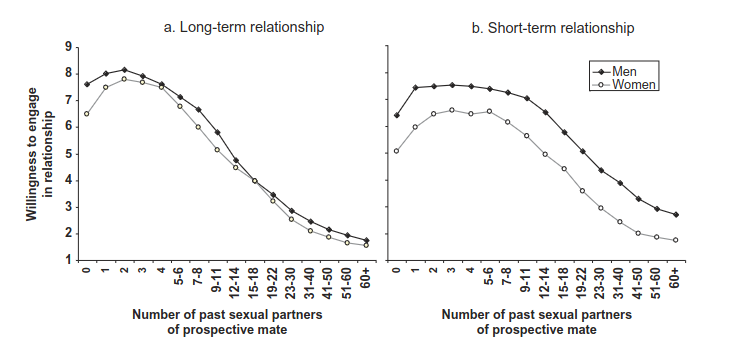
How consistent is that with my results? I found that 27% of men and 12% of women reported a virgin partner as their ideal. So, most people didn’t want a virgin. There was however a sex difference in ideal partner count, with women desiring a higher partner count on average.
For an analysis specifically on who wanted a virgin partner, see: Who are the men that demand virgins? In this, I also found that when participants did discontinue dating or a relationship for a high “body count” the number was quite high. For men, it was an average of 23 with a median of 17. For women, an average of 47.5 and a median of 40. In this, too, we see a substantial sex difference. “Body count” matters, but it has to be relatively high.
Below are charts for men and women showing ideal “body counts” in a romantic partner. Similar to what Stewart-Williams et al. (2016) found, the ideal partner had a relatively low number of past sexual partners.
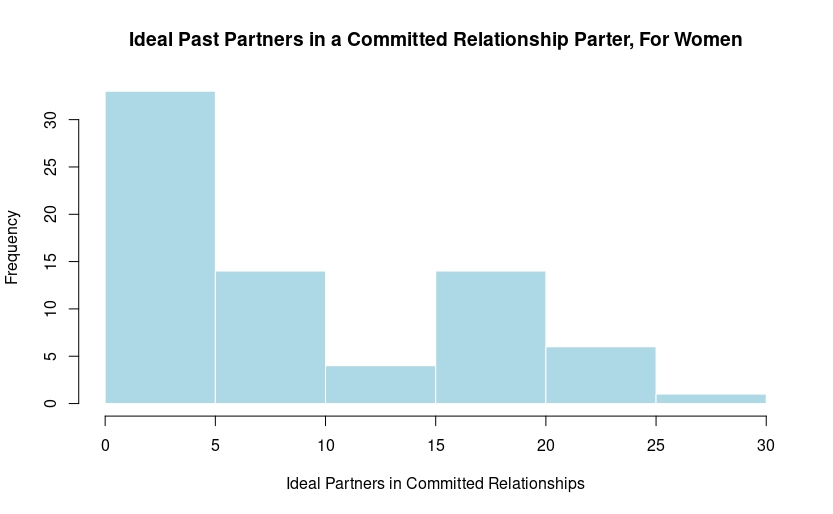

So, where do we see SDS in this data? Well, in stated preferences: men want a partner with a lower “body count” than women do. But, less in revealed preferences. Men and women didn’t report that their actual romantic partner had more or less of a sexual history. Men and women also weren’t very different in knowledge about a partner’s “body count,” nor did they inquire differently in the early dating process. Most people aren’t asking, filtering early for it, or ending relationships over it.
References
Endendijk, J. J., van Baar, A. L., & Deković, M. (2020). He is a stud, she is a slut! A meta-analysis on the continued existence of sexual double standards. Personality and Social Psychology Review, 24(2), 163-190.
Gómez-Berrocal, C., Moyano, N., Álvarez-Muelas, A., & Sierra, J. C. (2022). Sexual double standard: A gender-based prejudice referring to sexual freedom and sexual shyness. Frontiers in Psychology, 6469.
Šaffa, G., Duda, P., & Zrzavý, J. (2022). Paternity Uncertainty and Parent–Offspring Conflict Explain Restrictions on Female Premarital Sex across Societies. Human Nature, 33(2), 215-235.
Stewart-Williams, S., Butler, C. A., & Thomas, A. G. (2017). Sexual history and present attractiveness: People want a mate with a bit of a past, but not too much. The Journal of Sex Research, 54(9), 1097-1105.
Trivers, R. L. (2017). Parental investment and sexual selection. In Sexual selection and the descent of man (pp. 136-179). Routledge.
9 comments
These findings are interesting but difficult to take seriously when in the very first paragraph you note how unrepresentative this data is.
Overall it looks like the sampling method has captured only the high-sociosexuality tail of women, ie the women whose sexuality is more like that of men. Once you do that, no wonder the differences between male and female populations disappear. (Or spontaneously appear in places where they previously didn’t, eg 30% of women being bisexual, which is wild, and smells strongly of female agreeableness + more-than-female levels of horniness leading to women being willing to entertain the idea of a MFF threesome in order to pander to male sexual interests.)
There is no double standard, can’t be a double standard when the sexes are not equal. As a result of that there is a *different standard that applies to the two sexes on the basis of them being different, and it’s not “body count” either. It’s “notch count”.
Incorrect just because we have differences doesn’t mean we are different in every way and are to be held to different standards for example is stealing more or less wrong for men or women just because we have differences? well of course not, we are only to be held to different standards if their something that’s actually relevant to justify being held to different standards
Once again you make a blog post with horrible data and horrible sconce. You can not have a double standard for men and women. They are different standards . I don’t know what your not understanding about this lol
Nope we are only to be held to different standards on anything if theirs some actual difference affecting us on the matter, saying we have to be held to different standards on everything is absurd, yo act like men are woman are aliens fro different worlds lol